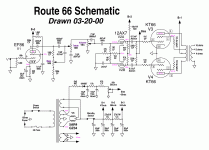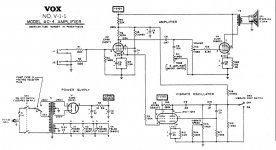The valvewizard page explains a pentode preamp based on the EF86, and how to get away with it. It can be quite microphonic in the vox design.
The Valve Wizard -Small Signal Pentode
The spitfire also uses this tube in the preamp.
The Valve Wizard -Small Signal Pentode
The spitfire also uses this tube in the preamp.
Last edited:
The input pentode circuitry for the VOX AC15 and other similar guitar amps was lifted straight from the back of a tube catalog. The trouble is, the schematic in the catalog was designed to extract the maximum possible voltage gain from the EF86, for use in microphone preamps, tape recorder playback preamps, record player magnetic cartridge preamps, et cetera.
Unfortunately, when this very high gain stage was used at the input to a guitar amp, it usually caused major problems with microphonics. The guitar amp would howl and screech, and even if you found an EF86 that didn't howl, it would usually "go bad" after a short time, and start howling and screeching (because the mica insulators holding the electrodes inside the bottle loosen up from vibration, eventually allowing the electrodes to move enough to cause the howling feedback.)
The problem was so bad that all the pentode-input guitar amps disappeared from the market within a few years.
You might have better luck if you modify the schematic to lower the voltage gain of the EF86 stage. Merlin Blencowe (the Valve Wizard) has a very helpful section on his website showing how to do this, and he even has a complete schematic there: The Valve Wizard -Small Signal Pentode
-Gnobuddy
Unfortunately, when this very high gain stage was used at the input to a guitar amp, it usually caused major problems with microphonics. The guitar amp would howl and screech, and even if you found an EF86 that didn't howl, it would usually "go bad" after a short time, and start howling and screeching (because the mica insulators holding the electrodes inside the bottle loosen up from vibration, eventually allowing the electrodes to move enough to cause the howling feedback.)
The problem was so bad that all the pentode-input guitar amps disappeared from the market within a few years.
You might have better luck if you modify the schematic to lower the voltage gain of the EF86 stage. Merlin Blencowe (the Valve Wizard) has a very helpful section on his website showing how to do this, and he even has a complete schematic there: The Valve Wizard -Small Signal Pentode
-Gnobuddy
Member
Joined 2009
Paid Member
Lot of widow-makers with 6AU6's been built with it being a higher gain tube. But when you have a big enough cabinet and a puny 8" there isn't that much concern. Through in another couple of gain stages and a pair of 12AB5's into a efficient 12", don't stop playing as the 6AU6 will go on singing without you.
I built a guitar preamp with a small signal pentode too, but I put the pentode at the output end of the preamp, not the input. Signal levels are larger here, so microphonic effects are further down in the noise. There is less gain in the signal chain after this point, so once again, less chance of microphony problems.
I also designed the pentode stage to have relatively low gain - IIRC it ended up at around x70 (about 37 dB), instead of the x200 or so (around 46 dB) in the old VOX amps. That's roughly 10 dB more breathing room before microphonics become a problem.
I haven't had any microphony problems in a couple of years of using the amp. Fingers crossed...
-Gnobuddy
I also designed the pentode stage to have relatively low gain - IIRC it ended up at around x70 (about 37 dB), instead of the x200 or so (around 46 dB) in the old VOX amps. That's roughly 10 dB more breathing room before microphonics become a problem.
I haven't had any microphony problems in a couple of years of using the amp. Fingers crossed...
-Gnobuddy
Member
Joined 2009
Paid Member
When small-signal pentodes first arrived on the market, it appears as though audio engineers were extremely excited at the possibility of getting high voltage gain from one stage (compared to triodes, which were all that they used to have previously.)220k resistor on the anode of EF86 and drops it down from around 320 and something volts down to 80?
Small-signal pentodes also cost more than small-signal triodes - they are more complicated, there is more delicate stuff inside, so the manufacturing process is more difficult. Perhaps extracting a lot of gain from one stage was also a way to try to sell these expensive new toys: "Look, you can get a gain of 250, five times more than you can expect from a 12AX7!"
The gain of a pentode stage is nearly gm x Ra, where gm is the transconductance, and Ra the anode resistance. When you see an enormous Ra like 220k, it is because the designer was trying to squeeze as much voltage gain as possible from the stage.
As you pointed out, one consequence of the huge Ra is a very low anode voltage. Pentodes will work with relatively little voltage on the anode, far less voltage than, say, a 12AX7.
Still, this is a clue that this gain stage was not designed to have a large output voltage swing - which, in turn, means it was designed for very small input signals. Probably signals from a reel-to-reel tape recorder playback head, dynamic microphone, or moving-coil (record player) cartridge, all of which tend to be far smaller than the signal from an electric guitar pickup.
So in addition to problems with microphonics, there is also a tendency for this input stage to overdrive when you plug a guitar into it. Some people like the result, others don't; many guitar amp designers say that getting a lot of distortion from one stage is a recipe for buzzy, fuzz-box tone, and a lack of dynamics. They say it is musically more interesting to spread out the total distortion over more than one gain stage, and get a relatively small amount of distortion out of each one by itself.
From what I've heard, the overdrive from this ancient not-for-guitar circuit doesn't sound very good by contemporary standards - not surprising, since it was never designed to overdrive, even back then. So when you overdrive it, it tends to sound blubbery and undefined, not crisp and clear. Similar to some of those old off-brand guitar amps Jack White used to use in the White Stripes. (In technical terms, there is lots of blocking distortion going on.)
Of course musical tastes - and guitar output levels - vary, so who knows, you may really like this sound.
-Gnobuddy
I think that was part of the appeal of using the small-signal pentode. All the gain you need, with one less valve, valve socket, etc.see also VOX 4....it's a simple two-tube amp.
-Gnobuddy
I think that was part of the appeal of using the small-signal pentode. All the gain you need, with one less valve, valve socket, etc.
-Gnobuddy
Always learn a great deal from you!
Thank you for supporting me in my tube amp building!
You are very welcome!Thank you for supporting me in my tube amp building!
-Gnobuddy
- Status
- This old topic is closed. If you want to reopen this topic, contact a moderator using the "Report Post" button.
- Home
- Live Sound
- Instruments and Amps
- EF86 guitar preamp circuit

